Nearly half of US arms exports over the past five years have gone to the war-stricken Middle East, with Saudi Arabia consolidating its place as the world’s second biggest importer, a report has shown.
The Stockholm International Peace Research Institute (Sipri) said on Monday that global transfer of major weapons systems between 2013 and 2017 rose by 10% compared with the five-year period before that, in a continuation of an upward trend that began two decades ago.
The US, which is the world’s biggest exporter, increased its sales between those two periods by 25%. It supplied arms to as many as 98 states worldwide, accounting for more than a third of global exports.
Russia, the world’s second biggest exporter, saw a decrease of 7.1% in its overall volume of arms exports; US exports were 58% higher than those of Russia.
France, Germany and China were also among the top five exporters. The UK is the sixth biggest weapons exporter.
“Based on deals signed during the Obama administration, US arms deliveries in 2013–17 reached their highest level since the late 1990s,” said Dr Aude Fleurant, the director of the Sipri’s arms and military expenditure programme. “These deals and further major contracts signed in 2017 will ensure that the USA remains the largest arms exporter in the coming years.”
The Middle East, a region where in the past five years most countries have been involved in conflict, accounted for 32% of global imports of weapons.
Arms imports to the region doubled between 2013 and 2017 and in the five-year period before that. The US, the UK, and France were the main supplier of arms to the region, while Saudi Arabia, Egypt and the UAE were the main recipient countries.
The UK, which rolled out a red carpet for the Saudi crown prince on his visit to London last week, exported nearly half of its arms to the Saudi Arabia, which has increased its imports by 225%. Sipri’s report noted that Saudi Arabia uses its imported weapons in large-scale combat operations, particularly in Yemen.
The Saudi-led military intervention in Yemen, which has cost hundreds of civilian lives, was launched in 2015, aiming to counter the advances of Iran-backed Houthi rebels controlling the capital, Sana’a. Saudi Arabia’s shopping list included 78 combat aircraft, 72 combat helicopters and 328 tanks.
“Widespread violent conflict in the Middle East and concerns about human rights have led to political debate in western Europe and North America about restricting arms sales,” said Pieter Wezeman, senior researcher with the Sipri’s arms and military expenditure programme.
“Yet the USA and European states remain the main arms exporters to the region and supplied over 98% of weapons imported by Saudi Arabia.”
In contrast, Saudi Arabia’s regional rival, Iran, which is propping up Bashar al-Assad’s regime in Syria, did not even make the list of the 40 largest importers – only accounting for 1% of arms imports to the region.
Iran, which is under an international arms embargo, spends a fraction of what its Arab neighbours spend on weapons, instead relying on proxies and soft power to advance its policies.
Israel increased its imports by 125%, receiving arms mainly from the US, Germany and Italy.
India, which receives most of its arms from Russia, heads the list of top importers. Egypt, UAE and China were also among the world’s top five importers.
“The tensions between India, on the one side, and Pakistan and China, on the other, are fuelling India’s growing demand for major weapons, which it remains unable to produce itself,” said Siemon Wezeman, senior researcher with Sipri’s arms and military expenditure programme.
“China, by contrast, is becoming increasingly capable of producing its own weapons and continues to strengthen its relations with Pakistan, Bangladesh and Myanmar through arms supplies.”
(THE GUARDIAN)
 简体中文
简体中文

